|
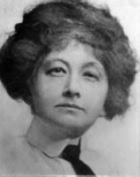 Florence Carlyle was one of the prominent women artists in Canada throughout the late nineteenth and early twentieth centuries,
during a period that saw the emergence of a significant number of professionally trained women artists.
She was elected an Associate member of the Royal Canadian Academy in 1897, in status identical to other exceptional women painters
between the date of the founding of the Academy in 1880 and 1933 (except for charter member Charlotte Schreiber,
who was given full membership). In 1899 in The Globe (Toronto), Mary Dignam, who founded the Women's Art Association of Canada,
wrote about Carlyle as one of the important portrait painters of the day, along with Robert Harris and Laura Muntz Lyall.
Florence Carlyle was one of the prominent women artists in Canada throughout the late nineteenth and early twentieth centuries,
during a period that saw the emergence of a significant number of professionally trained women artists.
She was elected an Associate member of the Royal Canadian Academy in 1897, in status identical to other exceptional women painters
between the date of the founding of the Academy in 1880 and 1933 (except for charter member Charlotte Schreiber,
who was given full membership). In 1899 in The Globe (Toronto), Mary Dignam, who founded the Women's Art Association of Canada,
wrote about Carlyle as one of the important portrait painters of the day, along with Robert Harris and Laura Muntz Lyall.
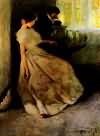 Carlyle's painting
The Tiff
with its subject of a man and a woman at odds with each other, brought her widespread success. In 1902, as a member of the
Ontario Society of Artists (to which she was elected in 1900), she received the OSA prize for this important but baffling work,
which reveals her taste for the unresolved, since the artist seemingly gives no clue either as to the nature of the small quarrel,
the relationship between the individuals, or the domestic interior (though on the table is one dazzlingly painted glass vase).
In the space between the two figures, there is something unsaid and withdrawn, as if they have formed their own subtle and private,
soon to be revealed, psychological network. Moreover, the painting has the effect of appearing drawn directly from the "real" world:
the dress on the woman, which dates from long before her day
(a writer in 1903 suggested it was from the time of her grandmother), indicates that the two individuals are artist's models,
who may pose soon for another subject. These interesting nuances, the masterly painting of dress and the ease of figural disposition,
the subtlety of interpretation, earned Carlyle the award. Carlyle's painting
The Tiff
with its subject of a man and a woman at odds with each other, brought her widespread success. In 1902, as a member of the
Ontario Society of Artists (to which she was elected in 1900), she received the OSA prize for this important but baffling work,
which reveals her taste for the unresolved, since the artist seemingly gives no clue either as to the nature of the small quarrel,
the relationship between the individuals, or the domestic interior (though on the table is one dazzlingly painted glass vase).
In the space between the two figures, there is something unsaid and withdrawn, as if they have formed their own subtle and private,
soon to be revealed, psychological network. Moreover, the painting has the effect of appearing drawn directly from the "real" world:
the dress on the woman, which dates from long before her day
(a writer in 1903 suggested it was from the time of her grandmother), indicates that the two individuals are artist's models,
who may pose soon for another subject. These interesting nuances, the masterly painting of dress and the ease of figural disposition,
the subtlety of interpretation, earned Carlyle the award.
The prize carried with it considerable renown and The Tiff was bought by the Ontario Provincial Government for $1000.
Subsequently, in 1904, shown in the Canadian section of the St. Louis World's Fair, the painting received a silver medal,
outdistancing the work of Carlyle's male compatriots in the same exhibition, outstanding and successful artists such as
William Brymner, William Cruikshank, E. Wyly Grier, John Hammond, Robert Harris, G.A. Reid and Homer Watson,
all of whom were full members of the R.C.A. (Harris was in fact its president.)
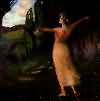 One reviewer hailed Carlyle's painting Pippa Passes
and gave it the place of honour in the exhibition in which it appeared
in Montreal in 1911, describing it as imaginative, with an admirable composition. Other writers praised the original poses
used by Carlyle, her rich and harmonious colouring, truthful rendering and the completeness of her conception.
Many of her works, too, were singled out for reproduction, a mark of their popularity - which is why so many of them were
inscribed by the artist with the word "Copyright" or "Copyrighted." Her painting When Mother Was a Girl, for instance,
which won First Prize in the Figure Painting Category of the Second Annual Osborne Calendar Company Competition in 1904,
was used as a post card by the National Art Company, New York. One reviewer hailed Carlyle's painting Pippa Passes
and gave it the place of honour in the exhibition in which it appeared
in Montreal in 1911, describing it as imaginative, with an admirable composition. Other writers praised the original poses
used by Carlyle, her rich and harmonious colouring, truthful rendering and the completeness of her conception.
Many of her works, too, were singled out for reproduction, a mark of their popularity - which is why so many of them were
inscribed by the artist with the word "Copyright" or "Copyrighted." Her painting When Mother Was a Girl, for instance,
which won First Prize in the Figure Painting Category of the Second Annual Osborne Calendar Company Competition in 1904,
was used as a post card by the National Art Company, New York.
The Tiff and Pippa Passes suggest Carlyle's gifts as an artist: in addition to the spectacular handling of
light and fabric, the figures are painted with great skill. In 1904, a month before the former work received the silver medal
in St. Louis, a reviewer in the Montreal Daily Star asserted Carlyle's importance to art in Canada, writing that she was,
perhaps, "foremost among the figure painters of the younger generation …." After her death in 1923, the well-known and
out-spoken critic Hector Charlesworth in Saturday Night wrote that she was one of a small group of women whose technical skill,
refinement of feeling and distinctive individuality gave interest to many exhibitions - a group that included Mary Hiester Reid,
whose career has recently returned to critical attention.
By contrast to Hiester Reid, whose work was described in reviews as "womanly," Carlyle's was described as "virile."
The word was used as a synonym for "strong" and it referred to her bold handling of paint. Carlyle was described by one artist
of the period as "not bothering with fussy little details, like many women painters do. She goes after the essentials."
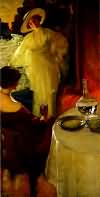 Likely the word also referred to the way Carlyle had positioned herself in art. Seeking a place in world art, she showed
and lived abroad for many years. Her neglect in Canadian art history is partly due to the rise of the Group of Seven,
with its rhetoric of a glorification of Canada's natural environment and stress on a sense of the sublime in landscape,
and partly due to her choice of the sensibility of the Aesthetic Movement in her work. Oscar Wilde had lectured on "The Decorative Arts"
in her home town of Woodstock, Ontario, in 1882, when she was eighteen years old, and his evangelical work on behalf of the
Aesthetic Movement for the domestic decorative arts had an indelible influence on her. Early on in her paintings she included choice,
beautiful objects as symbols of aesthetic beauty. She did so to glorify the expression of what Wilde had described in his lecture
as the "noblest side of his [man's] nature in the noblest way, to show the world how many things he can reverence, love, and understand."
Later, she also included specific objects to convey a story, if often an ambiguous one. The inclusion of a bowl or vessel made of glass
like the sparkling round vase on the table in The Tiff, for instance, was likely a convention borrowed from the Belgian writer,
mystic and member of the Aesthetic Movement Maurice Maeterlinck, who poetically referred to a glass jar as the vessel of the inner soul,
both shielded and separate from the outside world. (Thus, the artist may have intended the glass vase in The Tiff,
painted a scintillating yellow-green, to refer to a fit of jealousy.)
Likely the word also referred to the way Carlyle had positioned herself in art. Seeking a place in world art, she showed
and lived abroad for many years. Her neglect in Canadian art history is partly due to the rise of the Group of Seven,
with its rhetoric of a glorification of Canada's natural environment and stress on a sense of the sublime in landscape,
and partly due to her choice of the sensibility of the Aesthetic Movement in her work. Oscar Wilde had lectured on "The Decorative Arts"
in her home town of Woodstock, Ontario, in 1882, when she was eighteen years old, and his evangelical work on behalf of the
Aesthetic Movement for the domestic decorative arts had an indelible influence on her. Early on in her paintings she included choice,
beautiful objects as symbols of aesthetic beauty. She did so to glorify the expression of what Wilde had described in his lecture
as the "noblest side of his [man's] nature in the noblest way, to show the world how many things he can reverence, love, and understand."
Later, she also included specific objects to convey a story, if often an ambiguous one. The inclusion of a bowl or vessel made of glass
like the sparkling round vase on the table in The Tiff, for instance, was likely a convention borrowed from the Belgian writer,
mystic and member of the Aesthetic Movement Maurice Maeterlinck, who poetically referred to a glass jar as the vessel of the inner soul,
both shielded and separate from the outside world. (Thus, the artist may have intended the glass vase in The Tiff,
painted a scintillating yellow-green, to refer to a fit of jealousy.)
Following the tenets of the Aesthetic Movement too, Carlyle intended her portraits of women to convey their inner world of imagination
and spirituality in contrast to the prevailing strains of pragmatism and materialism in North American culture. In other paintings,
such as The Guest, Venice, the half-full glass decanter on the table might have a more traditional reference, perhaps to purity -
and thus the goodness and virtue of Carlyle’s friends, one of whom (the woman seated with her back to the viewer)
was her long-term companion, Juliet Hastings.
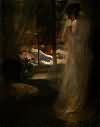
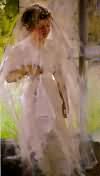 "Reverence" was an important word for Carlyle. "Reverence has always been the attitude of mind that Florence Carlyle has brought to her
art ... through the wonderful color and the fine technique shines the soul," a critic wrote of her work in 1912.
Moments of soulful reverence were often her subject, either of spiritual or aesthetic meditation, from
The Threshold, where a young woman prays for guidance on the eve of her wedding, to
Before Her First Communion,
literally a moment in the religious diary of a young woman, and Music, where a woman appears
lost in thought. "Find your subjects in everyday life: your own men and women, your own flowers and fields,
your own hills and mountains..." Wilde had said in his speech and, as if in reply, Carlyle painted Pippa Passes,
the poet Robert Browning's heroine in his poem of the same name (1841), "tripping lightly along the grass, her arms and hands in
rhythmic motion, as though chanting one of her songs." Sweetness and light, one of the useful cliches with which
to categorize the Aesthetic Movement, characterized many of Carlyle's paintings. She wanted to depict beauty, to civilize the public.
Today, these goals seem distant and her work far removed from the course of twentieth century modernism.
"Reverence" was an important word for Carlyle. "Reverence has always been the attitude of mind that Florence Carlyle has brought to her
art ... through the wonderful color and the fine technique shines the soul," a critic wrote of her work in 1912.
Moments of soulful reverence were often her subject, either of spiritual or aesthetic meditation, from
The Threshold, where a young woman prays for guidance on the eve of her wedding, to
Before Her First Communion,
literally a moment in the religious diary of a young woman, and Music, where a woman appears
lost in thought. "Find your subjects in everyday life: your own men and women, your own flowers and fields,
your own hills and mountains..." Wilde had said in his speech and, as if in reply, Carlyle painted Pippa Passes,
the poet Robert Browning's heroine in his poem of the same name (1841), "tripping lightly along the grass, her arms and hands in
rhythmic motion, as though chanting one of her songs." Sweetness and light, one of the useful cliches with which
to categorize the Aesthetic Movement, characterized many of Carlyle's paintings. She wanted to depict beauty, to civilize the public.
Today, these goals seem distant and her work far removed from the course of twentieth century modernism.
But is it? The Aesthetic Movement of the 1870s and 1880s gave birth to three different but closely related phenomena,
writes Lionel Lambourne - the Arts and Crafts Movement, Art Nouveau and, in literature, the movement known as the 'Decadence.'
The Arts and Crafts Movement was important to the development of Tom Thomson and the Group of Seven in Canada, as Dennis Reid
wrote recently in a catalogue essay for a major Thomson retrospective in 2002, so perhaps Carlyle is not so remote from today's
art history as we may think.
One  problem with Carlyle's work is that of chronology. She signed paintings regularly, but rarely dated them.
Their chronology, therefore, is uncertain. Some can be dated through contemporary literary sources, newspaper or magazine reviews.
I believe Mere Adele was described in an article in the Canadian Home Journal as follows: "An elderly peasant woman sitting
against her cottage wall in the open air, stooped shoulders, work-worn hands, sober care-wrought face, peasant dress and long blue
checked apron - a homely figure, yet intense in its womanly appeal…" The price of the work - $75.00 - suggests that it was of more
modest dimensions than a work Carlyle exhibited later in the year titled An Interesting Chapter, size 113.03 x 80.65 cm,
at a price of $100. I believe this painting may be the work known until now as Old Woman in Doorway in Museum London's collection.
Portrait of My Mother is also described in an article of the day: "the model, half reclining and fast asleep ... the bit of tapestry
in the background with its dulls, blues and greens a pleasing foil"
problem with Carlyle's work is that of chronology. She signed paintings regularly, but rarely dated them.
Their chronology, therefore, is uncertain. Some can be dated through contemporary literary sources, newspaper or magazine reviews.
I believe Mere Adele was described in an article in the Canadian Home Journal as follows: "An elderly peasant woman sitting
against her cottage wall in the open air, stooped shoulders, work-worn hands, sober care-wrought face, peasant dress and long blue
checked apron - a homely figure, yet intense in its womanly appeal…" The price of the work - $75.00 - suggests that it was of more
modest dimensions than a work Carlyle exhibited later in the year titled An Interesting Chapter, size 113.03 x 80.65 cm,
at a price of $100. I believe this painting may be the work known until now as Old Woman in Doorway in Museum London's collection.
Portrait of My Mother is also described in an article of the day: "the model, half reclining and fast asleep ... the bit of tapestry
in the background with its dulls, blues and greens a pleasing foil"
Concerning Carlyle herself, we know strangely little. She certainly knew the power of the press and gave a lively interview:
other sources offer plenty of anecdotes and quotations. There are numerous articles, but nothing in the body of literature tells us
more than generalities about what she thought. Even the few letters that have been saved indicate only the bare outlines of her beliefs.
Carlyle's cousin, Helene Youmans Key, is most revealing in a lengthy memoir, though perhaps not intentionally. Key recounts Carlyle's
love of "odd pieces of old velvets ... or a fold of satin ... She had trunks of this sort of thing, but was always looking for more."
She writes of Carlyle's desire to possess a green glass bowl in Tiffany's window in New York - of her love for this beautiful
bit of artistry. Carlyle's art tells a similar story, one deeper and more ambitious than mere ownership.
 But though the British Aesthetic Movement gave birth to the spirit of the work, the artists who captured her attention
in the context of world art were often American, particularly the American Aesthetic painters who, in 1897, formed
The Ten American Painters. In the work of these artists and their opposition to the status quo, she would have found an
outlook similar to her own. From them, she might have absorbed painterly ways to pursue what could be described as an ideal of beauty,
preferring to concentrate on the formal aspects of the work rather than on the anecdotal subject. One or two of her paintings recall
The Opal by Edmund C. Tarbell (1891), at least in mood; others Frank W. Benson, who painted, in Firelight (1893),
a woman who warms her hand at a fireplace located outside the picture. Other similarities are more general. According to Julia Gualtieri,
Carlyle's use of the female image as a metaphor for beauty and innocence, as in
The Moth, is reminiscent of
the work of American expatriate painter, John W Alexander, as in his The Butterfly (c.1890). In all these instances, however,
there is nothing slavish about Carlyle's reflections on such work. She was a free spirit in art as in life.
But though the British Aesthetic Movement gave birth to the spirit of the work, the artists who captured her attention
in the context of world art were often American, particularly the American Aesthetic painters who, in 1897, formed
The Ten American Painters. In the work of these artists and their opposition to the status quo, she would have found an
outlook similar to her own. From them, she might have absorbed painterly ways to pursue what could be described as an ideal of beauty,
preferring to concentrate on the formal aspects of the work rather than on the anecdotal subject. One or two of her paintings recall
The Opal by Edmund C. Tarbell (1891), at least in mood; others Frank W. Benson, who painted, in Firelight (1893),
a woman who warms her hand at a fireplace located outside the picture. Other similarities are more general. According to Julia Gualtieri,
Carlyle's use of the female image as a metaphor for beauty and innocence, as in
The Moth, is reminiscent of
the work of American expatriate painter, John W Alexander, as in his The Butterfly (c.1890). In all these instances, however,
there is nothing slavish about Carlyle's reflections on such work. She was a free spirit in art as in life.
Other artists into whose work she delved for inspiration include figures well-known in her day, for instance the American
James McNeill Whistler, one of the Aesthetic artists of the 1860s. Occasionally in her work she makes reference to certain paintings
by him and to his handling of space, flattened and two-dimensional, and sometimes thin paint application. Elsewhere, the brilliance
and brio of her technique, and sometimes her subject matter, evoke John Singer Sargent.
Her cousin recalled that some of the painters Carlyle highly regarded included Sir John Everett Millais, William Holman Hunt and
Sir Joshua Reynolds and she often visited St. Paul's Cathedral in London to commune with their graves. Her attachment to the
first two artists, both members of The Pre-Raphaelite Brotherhood, which they founded together with Dante Gabriel Rossetti in 1848,
is understandable. They represented a rejection of traditional academic practice in favour of a new form of naturalistic art,
an aim with which she would have been sympathetic, and she seems to have been drawn to the type of model sometimes found in
the work of Millais and Rossetti, one with ruddy colouring and long auburn hair. Reynolds, the eighteenth century artist renowned
for his sensitivity to children, she would have thought of as a great portraitist and likely knew of his insistence that painting
should draw its subjects from British literature and history. She responded at least once to his injunction in Pippa Passes,
a subject created by the poet Robert Browning .
Carlyle's cousin lists Millais first of the three and Millais would have been the most interesting to Carlyle. He must have thrilled
her with his rich and inventive colouring and through his command of sentiment, as expressed in the small but subtle gesture - a feature
of her finest work. "Take the best from everything," she might have said, as did the American artist William Merritt Chase. Her work is
a composite blend of old and new schools of painting, expressed in her own voice.
Carlyle regarded painting as a venture into some spiritual essence which drew upon a dynamic quality of faith and courage, as her cousin
wrote. Every time she started a new picture, she felt excited, "Just as if I were going on a wonderful journey or embarking
on some great adventure, as indeed I am." Carlyle's unfailing commitment to her quest is the thread that holds this exhibition
together - and that ultimately holds many of us in thrall to her work.
Joan Murray, Guest Curator, Woodstock Art Gallery
|